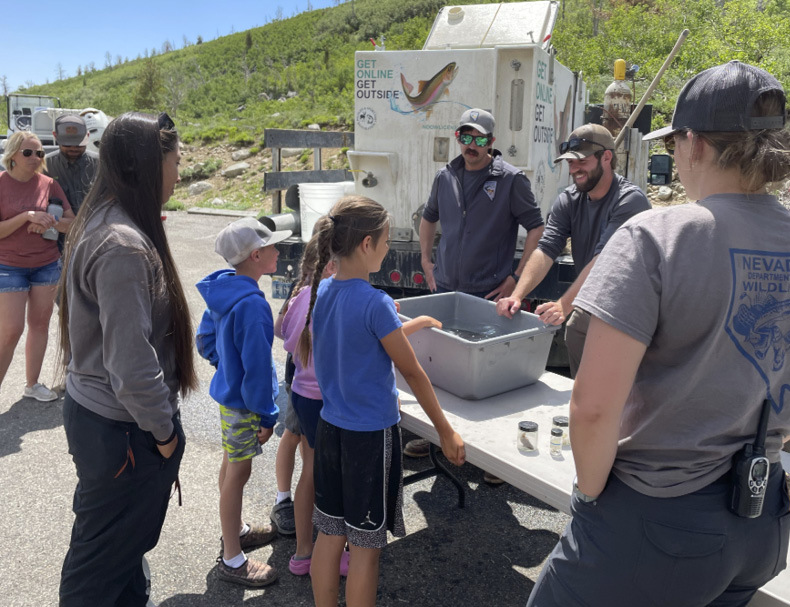Angling 101: Everyone’s Favorite Class

Gallagher Fish Hatchery staff teaching about the life cycle of a trout at the Angel Lake Kids Fishing Derby.
Angler Education Program
Did you know Nevada Department of Wildlife administers an entire program solely dedicated to educating the public about fishing techniques and opportunities? NDOW’s Conservation Education Division works to promote educational programs, services, and recreational opportunities, and one of those very important programs is the Angler Education Program. Run by a team of staff and volunteers statewide, the Angler Education Program delivers a variety of fishing related classes and activities to the public throughout the year. From kayak fishing clinics on Lake Mead, to fly fishing clinics in Reno, and ice fishing clinics in the northeast, we’ve got it covered.
Though fishing is a beloved hobby to many, it can also become an intimidating and expensive one! The Angler Education Program helps to mitigate those obstacles. Let’s say you want to try fly fishing for the first time. You walk into the sporting goods store and next thing you know you’re a couple of hundred dollars deep in brand new gear that you’re not sure how to use. Now, imagine you sign up for one of NDOW’s Introduction to Fly Fishing classes. There’s no class fee, all equipment is provided, and, perhaps most importantly, it is taught by skilled mentors who are eager to share all their tips and tricks with you. Better yet, you get to experiment with the sport before fully committing to it. If the latter sounds like the better option to you, check out our website!
Angler Education Programs
Go to register-ed.com/programs/nevada/210-angler-education to view all upcoming Angler Education Programs.
Essential Volunteers
So, how do we manage to run Angler Education events all over the state? NDOW’s staff Angler Education Coordinators are joined by a passionate crew of volunteers. Many of our programs would be impossible to run without the unwavering support of our Angler Education Volunteer Instructors. Volunteer Instructors assist NDOW’s Angler Education Coordinators with the implementation and instruction of a wide variety of programs. Some volunteers are fly-fishing gurus, some are bass fishing fanatics, and others like a little bit of everything as long as they are enjoying the great outdoors.

Why volunteer to help others learn to fish, when you could very well go fishing on your own in that same time? Well, have you ever witnessed the pride that radiates from a 5-year-old catching their first fish? That’s a common occurrence at the annual Free Fishing Day and derby events, and it never gets old. How about watching the nerves and uncertainty fade as a family encourages each other to step into waders, float tubes, or kayaks for the first time? We see confidence on or in the water skyrocket during our clinics. Of course, we can’t forget the look of pure satisfaction when an angler lands their first fish on a fly rod, especially on a fly they learned to tie themselves at one our fly-tying classes! All these reasons, plus many more, are why our volunteers are committed to this program. They experience the joy of sharing their passion for angling with others, and watch it ripple through the community time and time again. If the fulfillment from these experiences wasn’t already valuable enough, it is also important to note that all volunteer service provides the Department with federal in-kind match dollars that are used to fund the program. Volunteer hours and miles are awarded a specific dollar amount that are then matched 3:1 by the federal government. The match quickly adds up, allowing for the proliferation of Angler Education programming statewide. We need more volunteers, like you, to join the team and help make more memories on the water!
If this sounds like the right fit for you, contact your regional volunteer coordinator:
Western Region |
Eastern Region |
Southern Region |
|
775-688-1406 |
775-777-2388 |
702-668-3552 |

Teamwork With Fisheries
In addition to the Angler Education Coordinators and the Angler Education Volunteer Instructors, we have a third essential player on our team, and that’s the Fisheries Division. The Fisheries Division coordinates closely with Conservation Education Division staff to ensure fish stockings from Mason Valley and Gallagher Hatcheries occur in a timely manner to provide kids and other anglers the best opportunity to catch fish on Free Fishing Day and at other big events across the state. Angler Education events also allow for local Fisheries Biologists to share their knowledge and experience with managing various fisheries with participating anglers. Eastern Region Fisheries Supervisor Cody Byrne explained, “Introducing and recruiting new anglers is a critical piece to supporting our Sport Fish Restoration program, which provides angling opportunities around the state. NDOW’s sport fish management is largely funded through the sale of fishing licenses and excise taxes on fishing equipment that is allocated to the state annually.” With this funding model in place, the Angler Education Program serves not only to educate and provide angling opportunities, but also secure the future of both!

